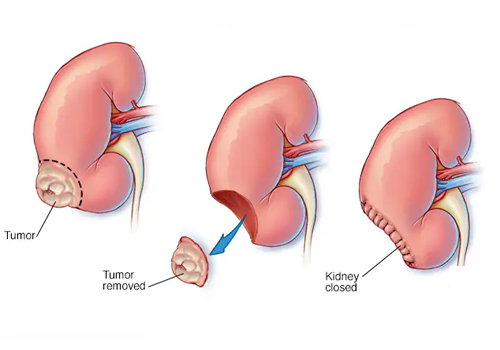
Nephrectomy- simple, radical, partial (Laparoscopic & open)
Nephrectomy is a surgical procedure to remove part or all of a kidney. It can be performed for various conditions such as kidney cancer, severe kidney damage, or donor kidney harvesting for transplantation. Depending on the extent of removal and surgical approach, nephrectomy is categorized as simple, radical, or partial, and can be done through laparoscopic or open surgery.
1. Types of Nephrectomy
A. Simple Nephrectomy
- Involves the removal of the entire kidney without surrounding tissues.
- Indications:
- Non-functioning kidney due to severe damage or infection.
- Chronic kidney disease with complications.
- Procedure:
- Kidney is removed via a laparoscopic or open approach.
- The ureter and renal vessels are ligated and cut.
B. Radical Nephrectomy
- Removal of the entire kidney along with the surrounding fatty tissue, adrenal gland (if involved), and sometimes nearby lymph nodes.
- Indications:
- Kidney cancer (renal cell carcinoma) involving the entire kidney.
- Large or invasive tumors.
- Procedure:
- More extensive than simple nephrectomy, requiring careful dissection of adjacent structures.
- Can be performed laparoscopically or via open surgery, depending on the tumor size and location.
C. Partial Nephrectomy
- Only the diseased or damaged portion of the kidney is removed, preserving the remaining healthy kidney tissue.
- Indications:
- Small kidney tumors (<4 cm).
- Benign tumors or localized cancer.
- Patients with a single kidney or poor overall kidney function.
- Procedure:
- The affected portion of the kidney is excised, and the remaining kidney is reconstructed.
- Requires precision, often performed laparoscopically or robotically for better outcomes.
2. Surgical Approaches
A. Open Nephrectomy
- Traditional approach with a large incision in the flank, abdomen, or back.
- Advantages:
- Better for large tumors or complex cases.
- Allows direct visualization and manipulation of surrounding structures.
- Disadvantages:
- Longer recovery time.
- Higher risk of complications like infection and scarring.
B. Laparoscopic Nephrectomy
- Minimally invasive approach using small incisions and a camera (laparoscope).
- Advantages:
- Faster recovery and shorter hospital stay.
- Less pain and minimal scarring.
- Suitable for simple, radical, or partial nephrectomies in selected cases.
- Disadvantages:
- Technically challenging for large tumors or extensive disease.
- May not be suitable for certain complex or advanced cancers.
Comparison of Open vs. Laparoscopic Nephrectomy
| Feature | Open Surgery | Laparoscopic Surgery |
|---|---|---|
| Incision | Large (10–20 cm) | Small (keyhole incisions) |
| Pain | More | Less |
| Recovery Time | 4–6 weeks | 2–3 weeks |
| Hospital Stay | 5–7 days | 2–4 days |
| Scarring | Significant | Minimal |
| Suitability | Complex or large tumors | Smaller tumors, elective cases |
3. Indications for Nephrectomy
- Kidney tumors (benign or malignant).
- Severe trauma to the kidney.
- Chronic infections unresponsive to treatment.
- Polycystic kidney disease causing pain or infection.
- Non-functioning kidney due to obstruction or severe damage.
- Kidney donation for transplantation.
4. Postoperative Care
- Hospital Stay:
- Open nephrectomy: 5–7 days.
- Laparoscopic nephrectomy: 2–4 days.
- Pain Management:
- Pain relievers (oral or intravenous) as prescribed.
- Activity Restrictions:
- Avoid heavy lifting for 4–6 weeks.
- Gradually resume daily activities as advised by the surgeon.
- Wound Care:
- Keep the incision area clean and dry.
- Watch for signs of infection (redness, swelling, fever).
- Follow-Up:
- Regular monitoring of kidney function.
- Imaging (if indicated) to ensure complete recovery or absence of disease recurrence.
Complications
- Bleeding or infection.
- Injury to nearby organs (e.g., spleen, pancreas).
- Postoperative hernia (more common with open surgery).
- Reduced kidney function (in cases of radical or partial nephrectomy).
Choosing the Right Procedure
The choice between simple, radical, or partial nephrectomy, and between laparoscopic or open surgery, depends on:
- The size, location, and extent of the kidney disease.
- The patient's overall health and kidney function.
- The surgeon's expertise and available technology.
For specific recommendations, consult a urologist with imaging studies (CT or MRI) and kidney function tests.

